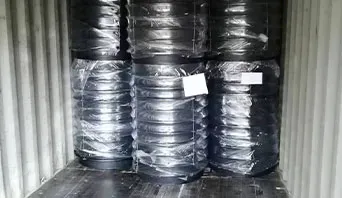Design and Functionality of Single Orifice Air Release Valves in Fluid Systems
Understanding the Single Orifice Air Valve A Critical Component in Fluid Systems
In the realm of fluid mechanics and hydraulic systems, the management of air within pipelines and tanks is paramount. One of the key components designed to handle this is the single orifice air valve. This specialized unit plays a vital role in preventing air accumulation, maintaining pressure balance, and ensuring the efficient operation of various fluid systems.
What is a Single Orifice Air Valve?
A single orifice air valve is a mechanical device that allows air to enter or escape a pipeline or tank at specific points. It typically consists of an inlet orifice that permits air to flow in or out when there are fluctuations in pressure, such as when fluid is being discharged or when a pipeline is being filled. The design of a single orifice air valve ensures that it functions effectively without hampering the flow of the liquid, thus maintaining system efficiency.
Applications of Single Orifice Air Valves
These valves are commonly utilized in a variety of applications, particularly in water distribution systems, sewage treatment plants, and irrigation systems. When pipelines are filled with water, air must be expelled to avoid the formation of air pockets that can hinder flow. Conversely, when water is drained, a single orifice air valve allows air to enter, preventing vacuum conditions that could lead to pipe collapse.
In addition to water systems, these valves are also found in industrial applications such as chemical processing, oil and gas operations, and even in heating and cooling systems. In these settings, the prevention of air accumulation not only helps in protecting equipment but also enhances the overall efficiency of the system.
How Does a Single Orifice Air Valve Work?
single orifice air valve

The operation of a single orifice air valve is relatively straightforward. When the pressure in the pipeline exceeds the atmospheric pressure, the valve opens to allow air to escape. This release of air helps to maintain positive pressure in the system and minimizes the risk of over-pressurization. Conversely, when the pressure inside the pipeline drops below atmospheric levels, the valve automatically opens to allow air to enter, thus preventing a vacuum condition.
The single orifice design is particularly important. Unlike more complex multiple orifice valves, a single orifice valve is easier to manage and maintain, making it an economically viable option for many systems. Its simple mechanism also minimizes the chances of mechanical failure, ensuring reliable performance over time.
Benefits of Using Single Orifice Air Valves
One significant advantage of single orifice air valves is their contribution to system efficiency. By preventing air pockets and vacuum conditions, they ensure that fluid flows uninterruptedly through pipes, which is crucial for operational efficiency. Additionally, their design reduces the risk of hydraulic shock, a phenomenon that can cause significant damage to piping systems.
Moreover, single orifice air valves are relatively low-maintenance components. Their simplicity means that fewer moving parts are susceptible to wear and tear, leading to lower operational costs and reduced downtime in systems.
Conclusion
In conclusion, the single orifice air valve is a fundamental element in modern fluid management systems. Its ability to regulate air flow in response to pressure changes not only enhances the efficiency and longevity of the system but also protects against potential damage caused by air accumulation and vacuum conditions. As industries continue to seek efficient and reliable fluid management solutions, the single orifice air valve will undoubtedly remain a crucial component in various applications, underscoring its importance in hydraulic engineering and fluid dynamics. Whether in municipal water systems, industrial processes, or agricultural applications, the significance of this simple yet effective device cannot be overstated.
-
The Smarter Choice for Pedestrian AreasNewsJun.30,2025
-
The Gold Standard in Round Drain CoversNewsJun.30,2025
-
The Gold Standard in Manhole Cover SystemsNewsJun.30,2025
-
Superior Drainage Solutions with Premium Gully GratesNewsJun.30,2025
-
Superior Drainage Solutions for Global InfrastructureNewsJun.30,2025
-
Square Manhole Solutions for Modern InfrastructureNewsJun.30,2025
-
Premium Manhole Covers for Modern InfrastructureNewsJun.30,2025
